key SKODA FABIA 2009 2.G / 5J Owner's Guide
[x] Cancel search | Manufacturer: SKODA, Model Year: 2009, Model line: FABIA, Model: SKODA FABIA 2009 2.G / 5JPages: 259, PDF Size: 31.99 MB
Page 74 of 259
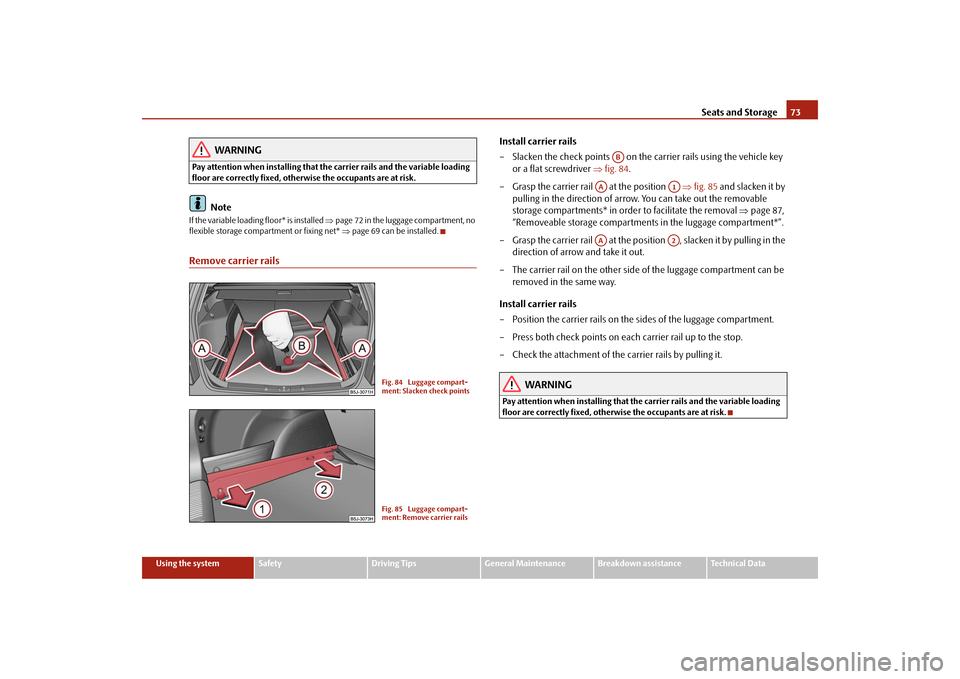
Seats and Storage73
Using the system
Safety
Driving Tips
General Maintenance
Breakdown assistance
Technical Data
WARNING
Pay attention when installing that the carrier rails and the variable loading
floor are correctly fixed, otherwise the occupants are at risk.
Note
If the variable loading floor* is installed ⇒page 72 in the luggage compartment, no
flexible storage compartment or fixing net* ⇒page 69 can be installed.Remove carrier rails
Install carrier rails
– Slacken the check points on the carrier rails using the vehicle key
or a flat screwdriver ⇒fig. 84.
– Grasp the carrier rail at the position ⇒fig. 85 and slacken it by
pulling in the direction of arrow. You can take out the removable
storage compartments* in order to facilitate the removal ⇒page 87,
“Removeable storage compartments in the luggage compartment*”.
– Grasp the carrier rail at the position , slacken it by pulling in the
direction of arrow and take it out.
– The carrier rail on the other side of the luggage compartment can be
removed in the same way.
Install carrier rails
– Position the carrier rails on the sides of the luggage compartment.
– Press both check points on each carrier rail up to the stop.
– Check the attachment of the carrier rails by pulling it.
WARNING
Pay attention when installing that the carrier rails and the variable loading
floor are correctly fixed, otherwise the occupants are at risk.
Fig. 84 Luggage compart-
ment: Slacken check pointsFig. 85 Luggage compart-
ment: Remove carrier rails
AB
AA
A1
AA
A2
s3f4.1.book Page 73 Thursday, June 18, 2009 11:07 AM
Page 84 of 259
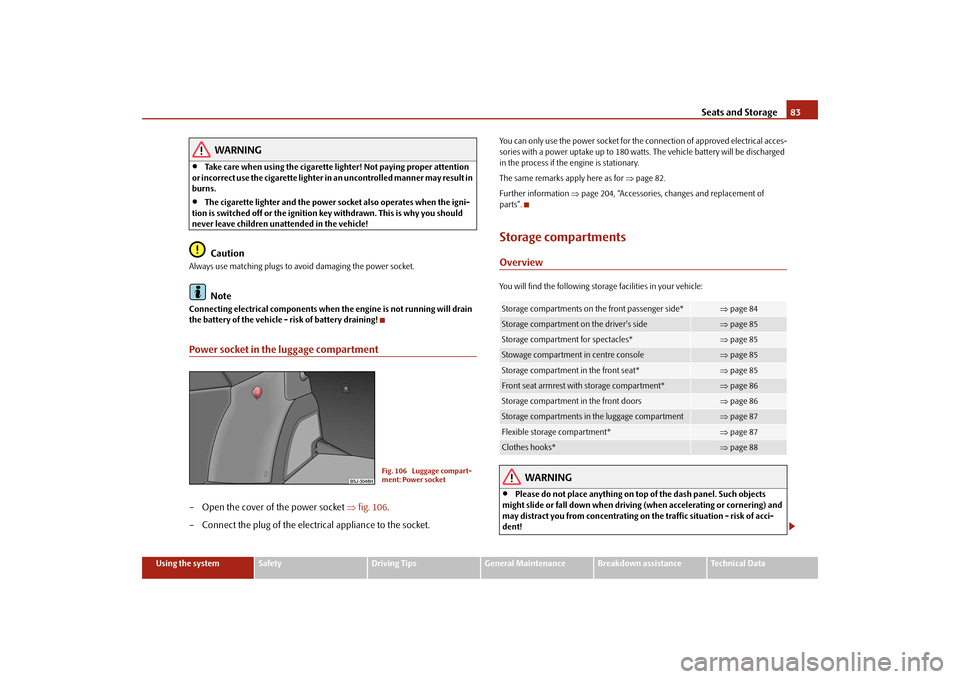
Seats and Storage83
Using the system
Safety
Driving Tips
General Maintenance
Breakdown assistance
Technical Data
WARNING
•
Take care when using the cigarette lighter! Not paying proper attention
or incorrect use the cigarette lighter in an uncontrolled manner may result in
burns.
•
The cigarette lighter and the power socket also operates when the igni-
tion is switched off or the ignition key withdrawn. This is why you should
never leave children unattended in the vehicle!Caution
Always use matching plugs to avoid damaging the power socket.
Note
Connecting electrical components when the engine is not running will drain
the battery of the vehicle - risk of battery draining!Power socket in the luggage compartment– Open the cover of the power socket ⇒fig. 106.
– Connect the plug of the electrical appliance to the socket.
You can only use the power socket for the connection of approved electrical acces-
sories with a power uptake up to 180 watts. The vehicle battery will be discharged
in the process if the engine is stationary.
The same remarks apply here as for ⇒page 82.
Further information ⇒page 204, “Accessories, changes and replacement of
parts”.Storage compartmentsOverviewYou will find the following storage facilities in your vehicle:
WARNING
•
Please do not place anything on top of the dash panel. Such objects
might slide or fall down when driving (when accelerating or cornering) and
may distract you from concentrating on the traffic situation - risk of acci-
dent!
Fig. 106 Luggage compart-
ment: Power socket
Storage compartments on the front passenger side*
⇒page 84
Storage compartment on the driver's side
⇒page 85
Storage compartment for spectacles*
⇒page 85
Stowage compartment in centre console
⇒page 85
Storage compartment in the front seat*
⇒page 85
Front seat armrest with storage compartment*
⇒page 86
Storage compartment in the front doors
⇒page 86
Storage compartments in the luggage compartment
⇒page 87
Flexible storage compartment*
⇒page 87
Clothes hooks*
⇒page 88
s3f4.1.book Page 83 Thursday, June 18, 2009 11:07 AM
Page 101 of 259
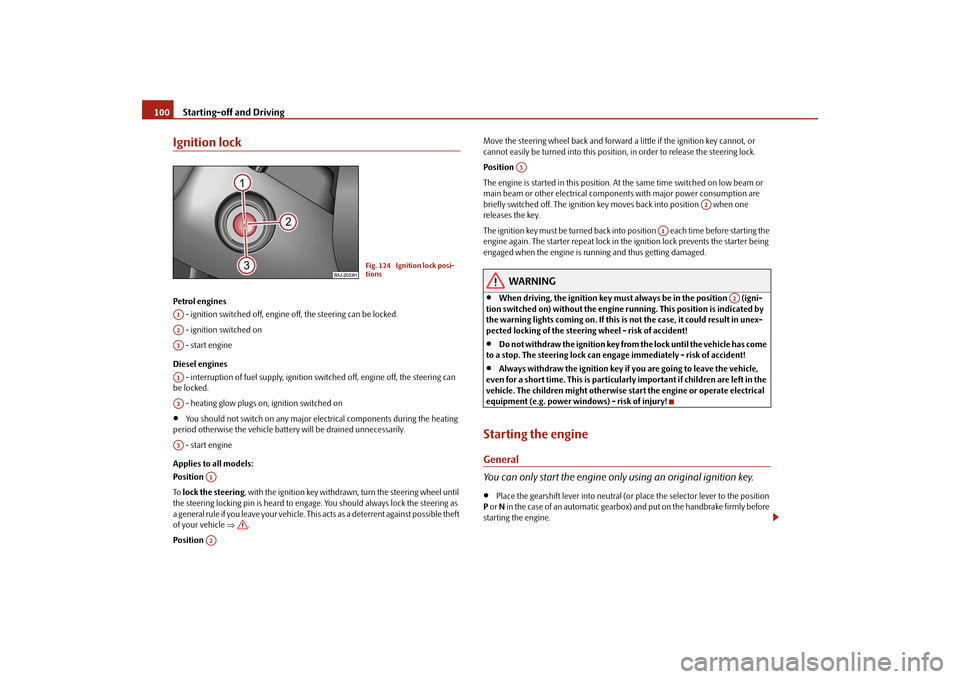
Starting-off and Driving 100Ignition lockPetrol engines
- ignition switched off, engine off, the steering can be locked.
- ignition switched on
- start engine
Diesel engines
- interruption of fuel supply, ignition switched off, engine off, the steering can
be locked.
- heating glow plugs on, ignition switched on•
You should not switch on any major electrical components during the heating
period otherwise the vehicle battery will be drained unnecessarily.
- start engine
Applies to all models:
Position
To lock the steering, with the ignition key withdrawn, turn the steering wheel until
the steering locking pin is heard to engage. You should always lock the steering as
a general rule if you leave your vehicle. This acts as a deterrent against possible theft
of your vehicle ⇒.
Position Move the steering wheel back and forward a little if the ignition key cannot, or
cannot easily be turned into this position, in order to release the steering lock.
Position
The engine is started in this position. At the same time switched on low beam or
main beam or other electrical components with major power consumption are
briefly switched off. The ignition key moves back into position when one
releases the key.
The ignition key must be turned back into position each time before starting the
engine again. The starter repeat lock in the ignition lock prevents the starter being
engaged when the engine is running and thus getting damaged.
WARNING
•
When driving, the ignition key must always be in the position (igni-
tion switched on) without the engine running. This position is indicated by
the warning lights coming on. If this is not the case, it could result in unex-
pected locking of the steering wheel - risk of accident!
•
Do not withdraw the ignition key from the lock until the vehicle has come
to a stop. The steering lock can engage immediately - risk of accident!
•
Always withdraw the ignition key if you are going to leave the vehicle,
even for a short time. This is particularly important if children are left in the
vehicle. The children might otherwise start the engine or operate electrical
equipment (e.g. power windows) - risk of injury!
Starting the engineGeneral
You can only start the engine only using an original ignition key.•
Place the gearshift lever into neutral (or place the selector lever to the position
P or N in the case of an automatic gearbox) and put on the handbrake firmly before
starting the engine.
Fig. 124 Ignition lock posi-
tions
A1A2A3A1A2A3
A1A2
A3
A2
A1
A2
s3f4.1.book Page 100 Thursday, June 18, 2009 11:07 AM
Page 102 of 259
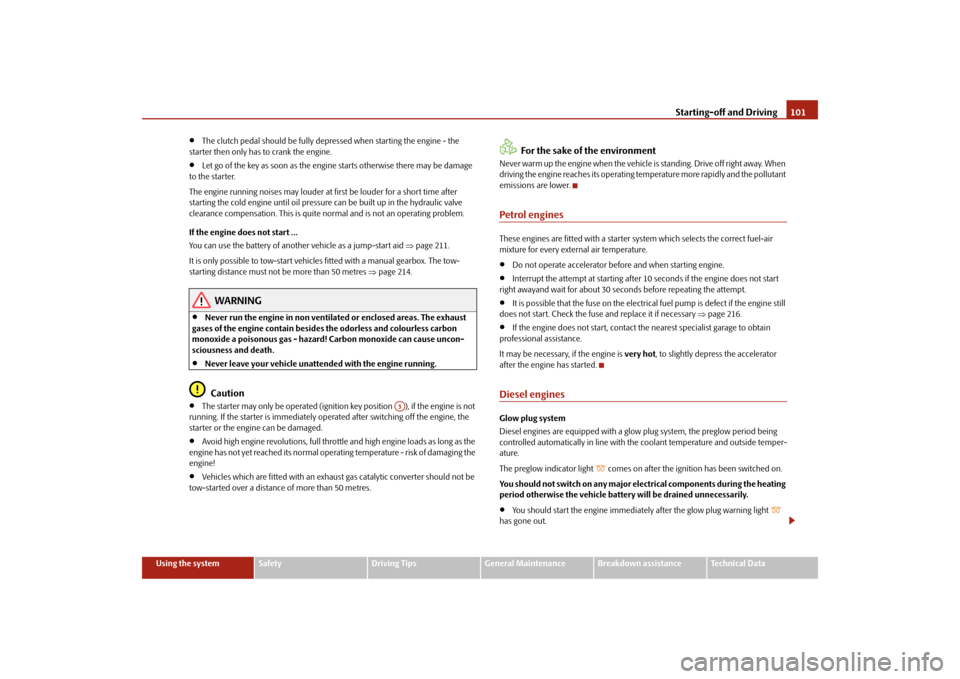
Starting-off and Driving101
Using the system
Safety
Driving Tips
General Maintenance
Breakdown assistance
Technical Data
•
The clutch pedal should be fully depressed when starting the engine - the
starter then only has to crank the engine.
•
Let go of the key as soon as the engine starts otherwise there may be damage
to the starter.
The engine running noises may louder at first be louder for a short time after
starting the cold engine until oil pressure can be built up in the hydraulic valve
clearance compensation. This is quite normal and is not an operating problem.
If the engine does not start ...
You can use the battery of another vehicle as a jump-start aid ⇒page 211.
It is only possible to tow-start vehicles fitted with a manual gearbox. The tow-
starting distance must not be more than 50 metres ⇒page 214.
WARNING
•
Never run the engine in non ventilated or enclosed areas. The exhaust
gases of the engine contain besides the odorless and colourless carbon
monoxide a poisonous gas - hazard! Carbon monoxide can cause uncon-
sciousness and death.
•
Never leave your vehicle unattended with the engine running.Caution
•
The starter may only be operated (ignition key position ), if the engine is not
running. If the starter is immediately operated after switching off the engine, the
starter or the engine can be damaged.
•
Avoid high engine revolutions, full throttle and high engine loads as long as the
engine has not yet reached its normal operating temperature - risk of damaging the
engine!
•
Vehicles which are fitted with an exhaust gas catalytic converter should not be
tow-started over a distance of more than 50 metres.
For the sake of the environment
Never warm up the engine when the vehicle is standing. Drive off right away. When
driving the engine reaches its operating temperature more rapidly and the pollutant
emissions are lower.Petrol enginesThese engines are fitted with a starter system which selects the correct fuel-air
mixture for every external air temperature.•
Do not operate accelerator before and when starting engine.
•
Interrupt the attempt at starting after 10 seconds if the engine does not start
right awayand wait for about 30 seconds before repeating the attempt.
•
It is possible that the fuse on the electrical fuel pump is defect if the engine still
does not start. Check the fuse and replace it if necessary ⇒page 216.
•
If the engine does not start, contact the nearest specialist garage to obtain
professional assistance.
It may be necessary, if the engine is very hot, to slightly depress the accelerator
after the engine has started.
Diesel enginesGlow plug system
Diesel engines are equipped with a glow plug system, the preglow period being
controlled automatically in line with the coolant temperature and outside temper-
ature.
The preglow indicator light
comes on after the ignition has been switched on.
You should not switch on any major electrical components during the heating
period otherwise the vehicle battery will be drained unnecessarily.
•
You should start the engine immediately after the glow plug warning light
has gone out.
A3
s3f4.1.book Page 101 Thursday, June 18, 2009 11:07 AM
Page 103 of 259
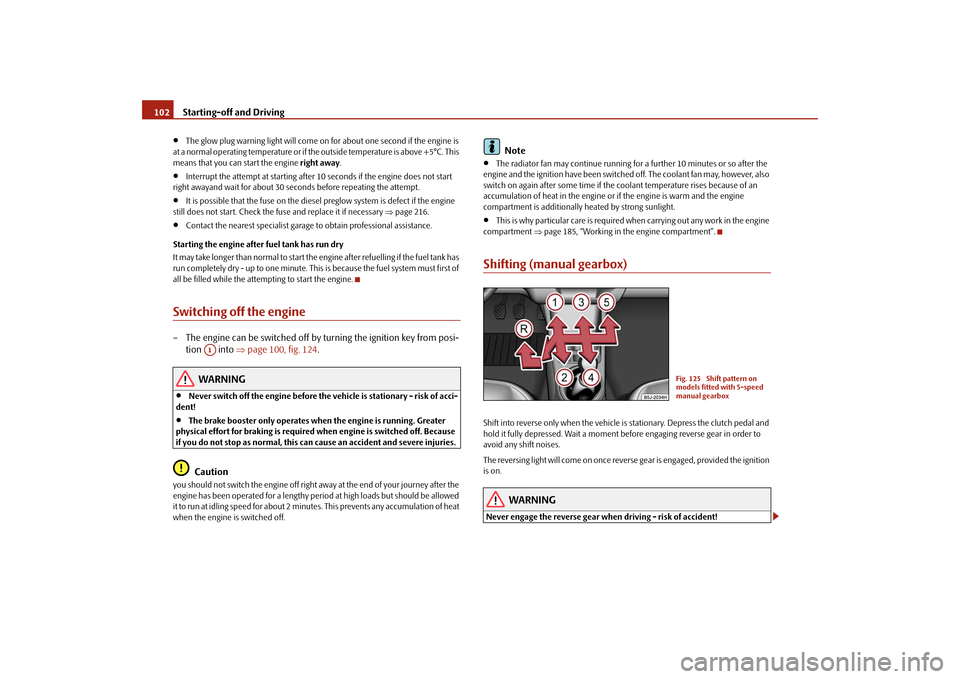
Starting-off and Driving 102•
The glow plug warning light will come on for about one second if the engine is
at a normal operating temperature or if the outside temperature is above +5°C. This
means that you can start the engine right away.
•
Interrupt the attempt at starting after 10 seconds if the engine does not start
right awayand wait for about 30 seconds before repeating the attempt.
•
It is possible that the fuse on the diesel preglow system is defect if the engine
still does not start. Check the fuse and replace it if necessary ⇒page 216.
•
Contact the nearest specialist garage to obtain professional assistance.
Starting the engine after fuel tank has run dry
It may take longer than normal to start the engine after refuelling if the fuel tank has
run completely dry - up to one minute. This is because the fuel system must first of
all be filled while the attempting to start the engine.
Switching off the engine– The engine can be switched off by turning the ignition key from posi-
tion into ⇒page 100, fig. 124.
WARNING
•
Never switch off the engine before the vehicle is stationary - risk of acci-
dent!
•
The brake booster only operates when the engine is running. Greater
physical effort for braking is required when engine is switched off. Because
if you do not stop as normal, this can cause an accident and severe injuries.Caution
you should not switch the engine off right away at the end of your journey after the
engine has been operated for a lengthy period at high loads but should be allowed
it to run at idling speed for about 2 minutes. This prevents any accumulation of heat
when the engine is switched off.
Note
•
The radiator fan may continue running for a further 10 minutes or so after the
engine and the ignition have been switched off. The coolant fan may, however, also
switch on again after some time if the coolant temperature rises because of an
accumulation of heat in the engine or if the engine is warm and the engine
compartment is additionally heated by strong sunlight.
•
This is why particular care is required when carrying out any work in the engine
compartment ⇒page 185, “Working in the engine compartment”.
Shifting (manual gearbox)Shift into reverse only when the vehicle is stationary. Depress the clutch pedal and
hold it fully depressed. Wait a moment before engaging reverse gear in order to
avoid any shift noises.
The reversing light will come on once reverse gear is engaged, provided the ignition
is on.
WARNING
Never engage the reverse gear when driving - risk of accident!
A1
Fig. 125 Shift pattern on
models fitted with 5-speed
manual gearbox
s3f4.1.book Page 102 Thursday, June 18, 2009 11:07 AM
Page 110 of 259
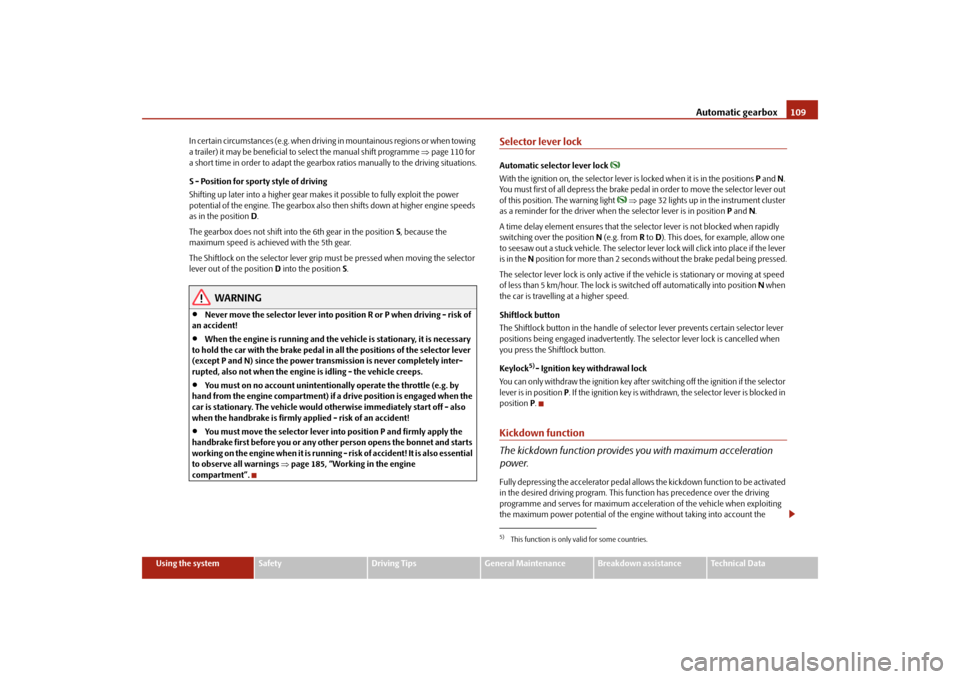
Automatic gearbox109
Using the system
Safety
Driving Tips
General Maintenance
Breakdown assistance
Technical Data In certain circumstances (e.g. when driving in mountainous regions or when towing
a trailer) it may be beneficial to select the manual shift programme ⇒page 110 for
a short time in order to adapt the gearbox ratios manually to the driving situations.
S - Position for sporty style of driving
Shifting up later into a higher gear makes it possible to fully exploit the power
potential of the engine. The gearbox also then shifts down at higher engine speeds
as in the position D.
The gearbox does not shift into the 6th gear in the position S, because the
maximum speed is achieved with the 5th gear.
The Shiftlock on the selector lever grip must be pressed when moving the selector
lever out of the position D into the position S.
WARNING
•
Never move the selector lever into position R or P when driving - risk of
an accident!
•
When the engine is running and the vehicle is stationary, it is necessary
to hold the car with the brake pedal in all the positions of the selector lever
(except P and N) since the power transmission is never completely inter-
rupted, also not when the engine is idling - the vehicle creeps.
•
You must on no account unintentionally operate the throttle (e.g. by
hand from the engine compartment) if a drive position is engaged when the
car is stationary. The vehicle would otherwise immediately start off - also
when the handbrake is firmly applied - risk of an accident!
•
You must move the selector lever into position P and firmly apply the
handbrake first before you or any other person opens the bonnet and starts
working on the engine when it is running - risk of accident! It is also essential
to observe all warnings ⇒page 185, “Working in the engine
compartment”.
Selector lever lockAutomatic selector lever lock
With the ignition on, the selector lever is locked when it is in the positions P and N.
You must first of all depress the brake pedal in order to move the selector lever out
of this position. The warning light
⇒page 32 lights up in the instrument cluster
as a reminder for the driver when the selector lever is in position P and N.
A time delay element ensures that the selector lever is not blocked when rapidly
switching over the position N (e.g. from R to D). This does, for example, allow one
to seesaw out a stuck vehicle. The selector lever lock will click into place if the lever
is in the N position for more than 2 seconds without the brake pedal being pressed.
The selector lever lock is only active if the vehicle is stationary or moving at speed
of less than 5 km/hour. The lock is switched off automatically into position N when
the car is travelling at a higher speed.
Shiftlock button
The Shiftlock button in the handle of selector lever prevents certain selector lever
positions being engaged inadvertently. The selector lever lock is cancelled when
you press the Shiftlock button.
Keylock
5)- Ignition key withdrawal lock
You can only withdraw the ignition key after switching off the ignition if the selector
lever is in position P. If the ignition key is withdrawn, the selector lever is blocked in
position P.
Kickdown function
The kickdown function provides you with maximum acceleration
power.Fully depressing the accelerator pedal allows the kickdown function to be activated
in the desired driving program. This function has precedence over the driving
programme and serves for maximum acceleration of the vehicle when exploiting
the maximum power potential of the engine without taking into account the 5)This function is only valid for some countries.
s3f4.1.book Page 109 Thursday, June 18, 2009 11:07 AM
Page 119 of 259

Communication 118The digits zero to nine are permitted. The system detects no continuous digit
combinations such as twenty-three, but only individually spoken digits (two, three).
After each order of digits (separation through brief voice pause) the detected digits
are repeated.
Notes for entering the PIN code•
When entering a PIN code with more than 8 digits, the system indicates “The
PIN is too long”.
•
When entering an incorrect PIN code, the system indicates “The PIN is incor-
rect”.
•
If the incorrect PIN code has been entered three times consecutively, the card
is blocked. With the aid of the personal unblocking code PUK (Personal Unblock
Key), the SIM card can be unblocked. The unblocking code can only be entered
via the phone keypad and not through the voice control.
Example for entering the PIN code
You can interrupt the dialogue at any time by pressing the PTT button or with the
voice command CANCEL.
Dial number– Press the PTT button.
– Give the command DIAL NUMBER after the signal tone.
After giving this command, the system requests the entry of a telephone number.
The telephone number can be entered as an interconnected spoken row of digits
(complete number), in the form of order of digits (separation through a brief voice
pause) or through individually spoken digits. After each order of digits (separation
through brief voice pause) the detected digits are repeated.
The digits zero to nine are permitted. The system detects no continuous digit
combinations such as twenty-three, but only individually spoken digits (two, three).
If you enter more than 20 digits, the system announces: “The number is too long”.
Additionally for international calls a Plus (+) has to be entered in front of the 20
digits.
Example when entering a telephone number
You can interrupt the dialogue at any time by pressing the PTT button or with the
voice command CANCEL.Repeat last call– Press the PTT button.
– Give the command REDIAL after the signal tone.
Voice command
Announcement
ENTER PIN/PIN CODE
“The PIN please”
e.g. ZERO ONE TWO THREE
“Zero One Two Three”
If no entry is put in, the following announcement is made after about 5 seconds.
“Possible commands are: store, repeat,
back, delete or more digits”
STORE
“The PIN is saved”
(end of dialogue)
Voice command
Announcement
DIAL NUMBER
“The number please”
e.g. ZERO SIX ZERO THREE
“Zero Six Zero Three”
If no entry is put in, the following announcement is made after about 5 seconds.
“Possible commands are: dial, repeat,
back, delete or more digits”
FIVE SEVEN TWO
“Five Seven Two”
DIAL
“The number is being dialed”
s3f4.1.book Page 118 Thursday, June 18, 2009 11:07 AM
Page 123 of 259
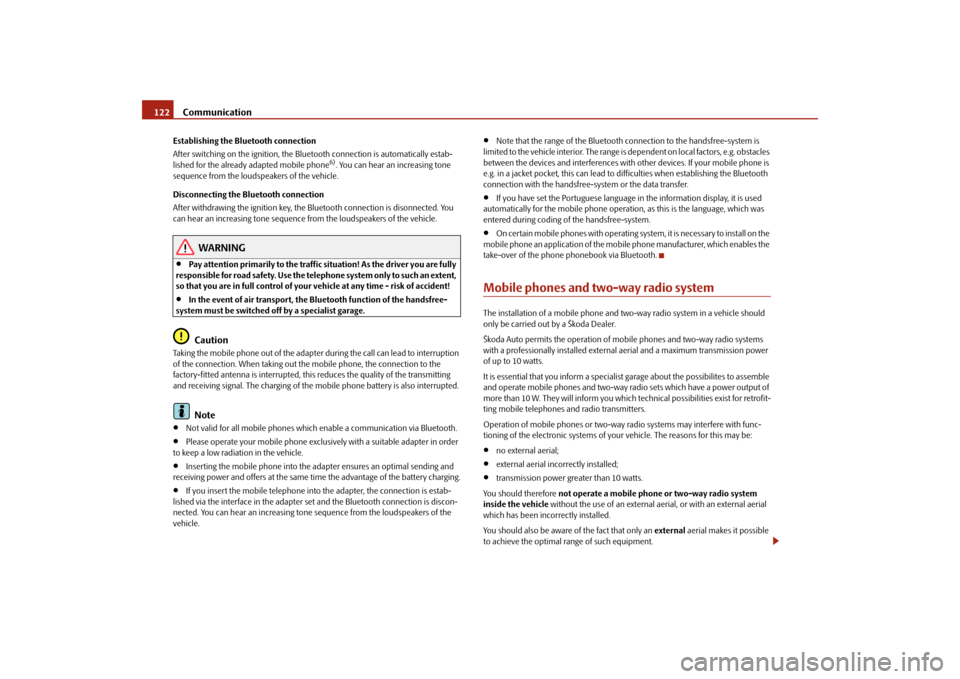
Communication 122Establishing the Bluetooth connection
After switching on the ignition, the Bluetooth connection is automatically estab-
lished for the already adapted mobile phone
6). You can hear an increasing tone
sequence from the loudspeakers of the vehicle.
Disconnecting the Bluetooth connection
After withdrawing the ignition key, the Bluetooth connection is disonnected. You
can hear an increasing tone sequence from the loudspeakers of the vehicle.
WARNING
•
Pay attention primarily to the traffic situation! As the driver you are fully
responsible for road safety. Use the telephone system only to such an extent,
so that you are in full control of your vehicle at any time - risk of accident!
•
In the event of air transport, the Bluetooth function of the handsfree-
system must be switched off by a specialist garage.Caution
Taking the mobile phone out of the adapter during the call can lead to interruption
of the connection. When taking out the mobile phone, the connection to the
factory-fitted antenna is interrupted, this reduces the quality of the transmitting
and receiving signal. The charging of the mobile phone battery is also interrupted.
Note
•
Not valid for all mobile phones which enable a communication via Bluetooth.
•
Please operate your mobile phone exclusively with a suitable adapter in order
to keep a low radiation in the vehicle.
•
Inserting the mobile phone into the adapter ensures an optimal sending and
receiving power and offers at the same time the advantage of the battery charging.
•
If you insert the mobile telephone into the adapter, the connection is estab-
lished via the interface in the adapter set and the Bluetooth connection is discon-
nected. You can hear an increasing tone sequence from the loudspeakers of the
vehicle.
•
Note that the range of the Bluetooth connection to the handsfree-system is
limited to the vehicle interior. The range is dependent on local factors, e.g. obstacles
between the devices and interferences with other devices. If your mobile phone is
e.g. in a jacket pocket, this can lead to difficulties when establishing the Bluetooth
connection with the handsfree-system or the data transfer.
•
If you have set the Portuguese language in the information display, it is used
automatically for the mobile phone operation, as this is the language, which was
entered during coding of the handsfree-system.
•
On certain mobile phones with operating system, it is necessary to install on the
mobile phone an application of the mobile phone manufacturer, which enables the
take-over of the phone phonebook via Bluetooth.
Mobile phones and two-way radio systemThe installation of a mobile phone and two-way radio system in a vehicle should
only be carried out by a Škoda Dealer.
Škoda Auto permits the operation of mobile phones and two-way radio systems
with a professionally installed external aerial and a maximum transmission power
of up to 10 watts.
It is essential that you inform a specialist garage about the possibilites to assemble
and operate mobile phones and two-way radio sets which have a power output of
more than 10 W. They will inform you which technical possibilities exist for retrofit-
ting mobile telephones and radio transmitters.
Operation of mobile phones or two-way radio systems may interfere with func-
tioning of the electronic systems of your vehicle. The reasons for this may be:•
no external aerial;
•
external aerial incorrectly installed;
•
transmission power greater than 10 watts.
You should therefore not operate a mobile phone or two-way radio system
inside the vehicle without the use of an external aerial, or with an external aerial
which has been incorrectly installed.
You should also be aware of the fact that only an external aerial makes it possible
to achieve the optimal range of such equipment.
s3f4.1.book Page 122 Thursday, June 18, 2009 11:07 AM
Page 135 of 259
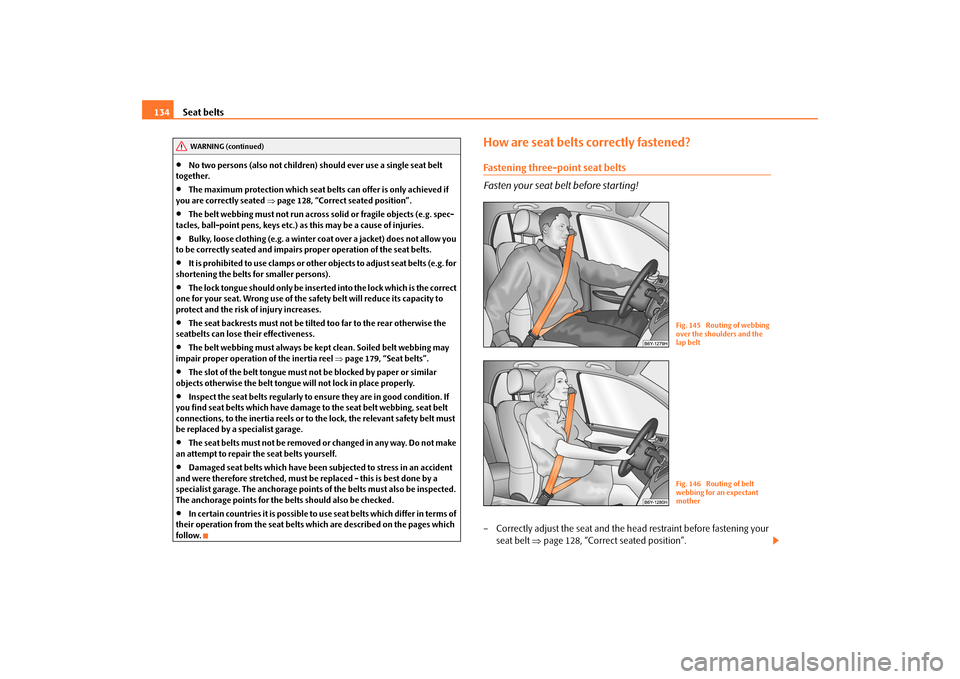
Seat belts 134•
No two persons (also not children) should ever use a single seat belt
together.
•
The maximum protection which seat belts can offer is only achieved if
you are correctly seated ⇒page 128, “Correct seated position”.
•
The belt webbing must not run across solid or fragile objects (e.g. spec-
tacles, ball-point pens, keys etc.) as this may be a cause of injuries.
•
Bulky, loose clothing (e.g. a winter coat over a jacket) does not allow you
to be correctly seated and impairs proper operation of the seat belts.
•
It is prohibited to use clamps or other objects to adjust seat belts (e.g. for
shortening the belts for smaller persons).
•
The lock tongue should only be inserted into the lock which is the correct
one for your seat. Wrong use of the safety belt will reduce its capacity to
protect and the risk of injury increases.
•
The seat backrests must not be tilted too far to the rear otherwise the
seatbelts can lose their effectiveness.
•
The belt webbing must always be kept clean. Soiled belt webbing may
impair proper operation of the inertia reel ⇒page 179, “Seat belts”.
•
The slot of the belt tongue must not be blocked by paper or similar
objects otherwise the belt tongue will not lock in place properly.
•
Inspect the seat belts regularly to ensure they are in good condition. If
you find seat belts which have damage to the seat belt webbing, seat belt
connections, to the inertia reels or to the lock, the relevant safety belt must
be replaced by a specialist garage.
•
The seat belts must not be removed or changed in any way. Do not make
an attempt to repair the seat belts yourself.
•
Damaged seat belts which have been subjected to stress in an accident
and were therefore stretched, must be replaced - this is best done by a
specialist garage. The anchorage points of the belts must also be inspected.
The anchorage points for the belts should also be checked.
•
In certain countries it is possible to use seat belts which differ in terms of
their operation from the seat belts which are described on the pages which
follow.
How are seat belts correctly fastened?Fastening three-point seat belts
Fasten your seat belt before starting!– Correctly adjust the seat and the head restraint before fastening your
seat belt ⇒page 128, “Correct seated position”.
WARNING (continued)
Fig. 145 Routing of webbing
over the shoulders and the
lap beltFig. 146 Routing of belt
webbing for an expectant
mother
s3f4.1.book Page 134 Thursday, June 18, 2009 11:07 AM
Page 147 of 259
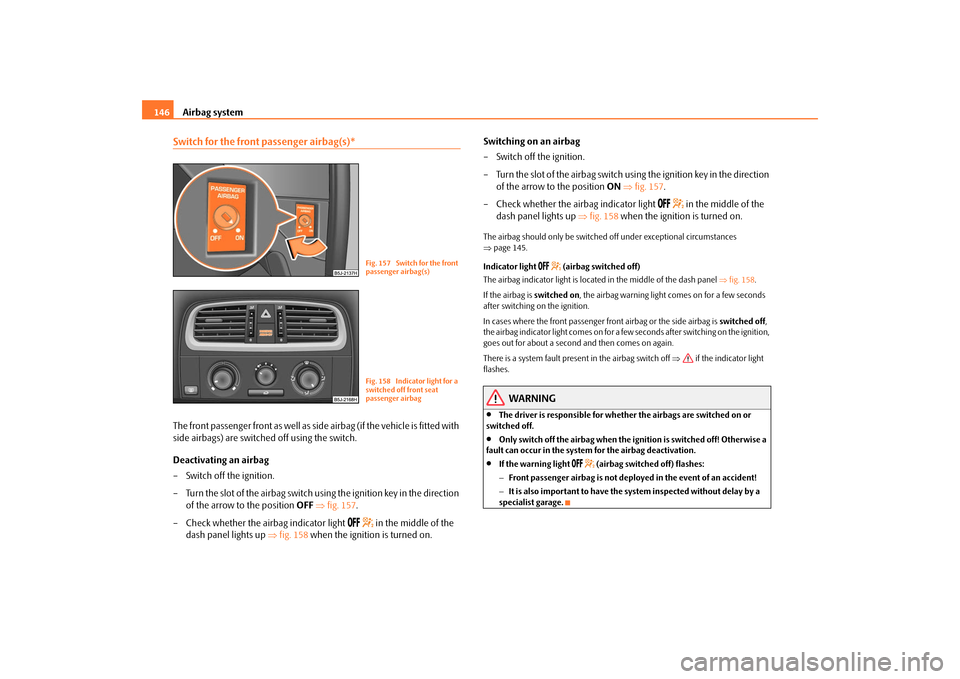
Airbag system 146Switch for the front passenger airbag(s)*The front passenger front as well as side airbag (if the vehicle is fitted with
side airbags) are switched off using the switch.
Deactivating an airbag
– Switch off the ignition.
– Turn the slot of the airbag switch using the ignition key in the direction
of the arrow to the position OFF ⇒fig. 157.
– Check whether the airbag indicator light
in the middle of the
dash panel lights up ⇒fig. 158 when the ignition is turned on.Switching on an airbag
– Switch off the ignition.
– Turn the slot of the airbag switch using the ignition key in the direction
of the arrow to the position ON ⇒fig. 157.
– Check whether the airbag indicator light
in the middle of the
dash panel lights up ⇒fig. 158 when the ignition is turned on.
The airbag should only be switched off under exceptional circumstances
⇒page 145.
Indicator light
(airbag switched off)
The airbag indicator light is located in the middle of the dash panel ⇒fig. 158.
If the airbag is switched on, the airbag warning light comes on for a few seconds
after switching on the ignition.
In cases where the front passenger front airbag or the side airbag is switched off,
the airbag indicator light comes on for a few seconds after switching on the ignition,
goes out for about a second and then comes on again.
There is a system fault present in the airbag switch off ⇒ if the indicator light
flashes.
WARNING
•
The driver is responsible for whether the airbags are switched on or
switched off.
•
Only switch off the airbag when the ignition is switched off! Otherwise a
fault can occur in the system for the airbag deactivation.
•
If the warning light
(airbag switched off) flashes:
−Front passenger airbag is not deployed in the event of an accident!
−It is also important to have the system inspected without delay by a
specialist garage.
Fig. 157 Switch for the front
passenger airbag(s)Fig. 158 Indicator light for a
switched off front seat
passenger airbag
s3f4.1.book Page 146 Thursday, June 18, 2009 11:07 AM